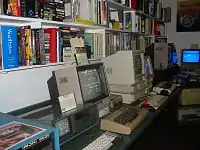Personal Computer Museum
The Personal Computer Museum was located in Brantford, Ontario, Canada, in a building formerly owned by the municipal government. The building was built with bricks reclaimed from the Brantford Opera House.
 Some personal computers on an interactive display. | |

| |
| Established | 2005 |
|---|---|
| Dissolved | 2018 |
| Location | Brantford, Ontario, Canada |
| Coordinates | 43.15720°N 80.26501°W |
| Type | Personal Computer museum |
| Curator | Syd Bolton |
| Website | http://www.pcmuseum.ca/ |
Over fifty interactive personal computers were on display, from a wide variety of manufacturers, including Apple, Atari, Commodore, IBM, Radio Shack, Timex, Mattel, and others. The museum also had a large library of original software and a huge archive of computer-related magazines.
The museum's mandate was to preserve computer technology and, more importantly, to offer interactivity with older machines. It welcomed private tours from schools and other groups. It was open to students, to study the origins of computers and the various technologies involved. Parents were welcome to bring children, to see computers which the parents may have once used, to get a sense of the ancestry of today's technology. Admission was free.
The museum first opened to the public in September, 2005.[1] It was run by Syd Bolton, its founder and curator, and by a group of dedicated volunteers.
The museum closed permanently after the curator's death. At that time, it had been open to the public only one day a month. Its contents are slated to be dispersed to another agency.
Displays

- The downstairs showcases over forty-five machines that are interactive. The most popular machines include the Commodore 64, IMSAI 8080 and Apple IIe
- Video games and consoles are also represented. One rare Atari 2600 title is an "Extra Terrestrials" cartridge published in 1983 by a small Burlington, Ontario firm unaware of Atari's similarly themed 1982 'ET' game, a massive commercial failure which was a factor in the video game crash of 1983.[2]
- There is a 1953 Admiral Black & White television downstairs connected to a game of Pong
- The 'Tower of Power' is a 16-foot (4.9 m) high display that includes the original packaging for such machines as the Coleco Adam, Atari 2600, and Mattel Aquarius
- Upstairs contains a magazine library that has classics such as Byte Magazine and Compute!. The library is home to over 4,000 publications.
- Upstairs also has a display known as 'Modem Alley' where the history of the modem is displayed including the major milestones contributed by manufacturers such as Hayes Microcomputer Products and Supra, Inc.
- Both levels include hundreds of books on various topics in computer history
- A special section devoted to Canadian journalist and technology evangelist Jim Butterfield is on permanent display
Computer recycling
The Personal Computer Museum engages in computer recycling. Local residents can bring computers to the museum almost every Monday evening for safe, proper recycling. Computers that are still viable for redistribution are given away to needy families through the computer giveaway program.[3] The museum also has an annual 'Spring Cleanup' event with a special focus on recycling that brought in over 400 pieces of electronics in 2008.[4]
Notable events
- Between June 26 and June 29, 2009 Microsoft hired the museum to fill its 'Evolution: 30 Years of Gaming' display in Toronto[5]
- On September 13, 2008 the Personal Computer Museum held and established a new Guinness World Records attempt for the most players in a Tetris Tournament[6]
- On March 26, 2009 the museum received a 'Shining Stars Tourism Award' for the best marketing campaign for a facility with under 30,000 visitors annually[7]
- On June 13, 2009 the museum was host to Andy Walker, Sean Carruthers, and Matt Harris who shot an episode of LabRats.TV[8]
- On February 20, 2010 the museum was host to the oldest known computer to send a tweet on Twitter, the VIC-20, using code written by Syd Bolton.[9]
- On October 13, 2011 the museum received a 'Shining Stars Tourism Award' for the event "Guitar Hero Rocks the Square" and museum curator Syd Bolton received the "Tourism Innovator" award[10]
- On November 15, 2014 Jack Livesley and former TVOntario staff, as well as the former editor of The Transactor, held a talk and Q&A session, reminiscing about the early days of Bits and Bytes and personal computers.[11]
- On June 11, 2018 the founder and curator Syd Bolton died peacefully in a Toronto hospital after a brief illness. He was 46.[12]
See also
Notes
- Brantford Expositor Newspaper Article - September 20, 2005
- "The Atari E.T. video game you didn't know existed". CBC Hamilton. 2014-04-29. Retrieved 2014-04-30.
- PCM giving away computers to the Needy, Brantford Expositor Newspaper January 31 2009
- E-Waste: The Buck Stops Here, Globe & Mail Newspaper, October 20 2008
- Ars Technica: Microsoft Touts PC Gaming With Retro Computer Showcase
- Tetris Tourney a Big Draw in the Brantford Expositor Newspaper, September 15, 2008
- "Tourism's 'Shining Stars' honoured" in the Brantford Expositor, retrieved March 27, 2009
- LabRats.TV Episode 176
- Reisinger, Don (2010-02-16). "Commodore VIC-20 prepares for first-ever tweet". CNet. Retrieved 2014-04-30.
- http://www.discoverbrantford.com/Tourism%20Documents/MediaRelease_TourismAwardsWinners2011.pdf
- "An Afternoon with Jack Livesley". Personal Computer Museum. Retrieved 16 February 2017.
- "Syd Bolton, computer and video game collector, dies at age 46". CTV Kitchener. Retrieved 12 June 2018.
External links
- Personal Computer Museum website
- Collection of old analog and digital computers at Old Computer Museum
